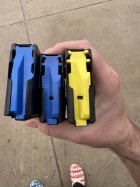This is where the rabbit hole takes a turn. People treat bolt action loads and AR15 lads the same. The would be much better off treating them as different cartridges. To get subs to cycle an AR, you leave some great powders on the shelf. Then depending on the rifle set up, single shot or magazine fed using an AI pattern magazine, the 2.260” max length becomes around 2.485”. It’s a handloaders dream.
Then monolithic bullets adds to the fun.
Leave twist out for the moment, because that will be design dependent and anything between 7-10 will stabilize most everything out there.
Subsonic loads in general are low pressure, under 30,000 psi. This works great for cup and core bullets. Mostly terrible for monolithic. You want enough pressure to obturate the bullet base and seal the gasses behind the bullet. That works for a cup and core, but depending on the copper alloy, that might take over 40,000 psi. What that does is you get gas cutting on many monolithic bullets at subsonic velocities and low pressure. In an AR, the powders fast enough to develop higher pressures, are too fast to cycle the action. Or they only work in short barrels, losing 8” of barrel reduces velocity enough that what would normally be a super load stays sub. 296/H110 is about as fast as you can go in a 16” or longer barrel in an AR. There is some data out there for #9 and N105 for subs.
With a bolt action, you don’t have to worry about gas to cycle. You can use powders like Accurate #2, 5, 9, Bullseye, Titegroup, N320. What these do is up the pressure, some to over 40,000 psi. That’s enough to get the hardest copper bases to seal the bore improving accuracy.
Side effects of faster powder are that you use less, burn a higher percentage, reduce muzzle pressure, reduce carbon build up, lower your sound signature and get more loads per pound.
Old Whisper data is very different than 300 BLK, but is valid, you can use it.
With twists between 7-10, you really only need to worry about a low percentage of bullets and if you’re talking hunting bullets there are probably only a few.1/10 is the most likely to be a problem with stability. On the fast end of the twist rate, at subsonic velocities bullets just aren’t spinning fast enough to come apart.
So then distance you shoot comes into play. If you’re on the edge of being stable with a 1/10, where does it start to effect the bullet? This can be trial and error. Example a bullet that shoots great at 100 yards, keyholes at 200, goes through the paper sideways at 300, can be a great bullet if you never shoot past 75-100 yards. That information is impossible with pencil and paper.
Bullet performance is less complicated. It opens or it doesn’t it’s accurate enough or not. Cup and core rarely expand more than double caliber and tend to have a lower working window. I mentioned the Nosler 190 earlier. Minimum impact for any expansion 950 fps. I like to load subs around 1000 fps. That’s outside the bullets performance window. The fact that it continually shed its jacket in gel tests pretty much ruled out me ever using that bullet.
Cup and core work on blunt force trauma, they don’t poke or cut a hole in anything. They just tear their way through. It works well and is reliable. Round nose, flat point, doesn’t matter, the size of the metplat determines the size of the entrance hole. Expanded diameter, weight and kinetic energy based on velocity determines surrounding tissue damage. With proper shot placement very effective. More likely to have an exit hole.
Most monolithic bullets open up and cut or slice their way through, much like a broad head. Tissue damage in general is less, but 3 or 4 one inch slices through the vitals again is pretty effective.
For the most part, it’s simply a choice.
The biggest decision about twist rate is if you want an off the shelf rifle. For a bolt action 1/7 is most common, probably a couple 1/8 out there. 1/10 will be custom.
For my purposes I like the 220 Maker. It was developed for a 1/5 twist so is tough. Expands down to below 600 fps. I ran it as high as 1200 fps and all the petals stayed intact with a 1/5 twist. Slightly over MOA accuracy at 200 yards in both a 1/5 an 1/10. Mostly vertical. It’s not a very graceful bullet, all business.
The plus side of a bolt action is that 85 grain 30 Luger and Mauser bullets work subsonic as well as a 100 grain Maker. It’s a pretty versatile cartridge.
One last thing to keep in mind is that with bolt action subs barrels length does not matter. I load the same bullet to the same speed in any thing from 5” to 24”. Just adjust powder accordingly.
Sorry I can’t answer directly which is best, hopefully enough info to make your own choice.











